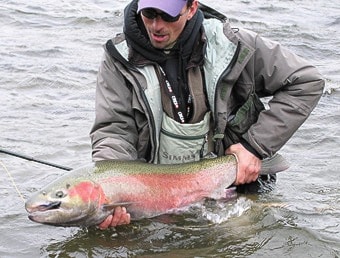Thompson River Steelhead are in a serious, decades-long decline that has seen stocks drop from ten to twenty thousand a year in the early 1970s, to fewer than 400 spawning fish this year. The Thompson Steelhead Working Group is trying to address the issue, and recently released a draft Thompson Steelhead Recovery and Management Plan.
“The Steelhead are an absolutely vital part of Nlaka’paxum culture and a food source for winter,” says David Walkem, chief of the Cook’s Ferry Band (CFB) at Spences Bridge. “It [fishing for steelhead] was a major cultural activity in winter, that’s been lost since the 1970s.”
Walkem says that up to 20,000 Thompson Steelhead returned every year until 1971/72, but that the returning stock dropped in half after that, and has gone down gradually every year since.
“A lot of people, including my family, voluntarily stopped fishing in the early 1970s,” he notes, adding that “Elders at the time said ‘Let’s hold off.’ We used to get a boat load of fish in two passes of a one kilometre stretch of river.
“I went fishing once, in the 1990s, and saw three fish. We only caught one.”
He acknowledges the importance of the Thompson Steelhead as an economic driver for Spences Bridge and the area: the fish are world-renowned, and attracted myriad sportsmen to the area, prompting the building of motels, restaurants, gas stations, and other amenities in the area.
“Now we only have a part-time grocery store, and no gas stations. At one time we had seven. The building of the Coquihalla Highway, and the lack of economic activity, has devastated Spences Bridge since the 1980s.”
The CFB hosted a number of meetings to look at the situation, but had little support. In 2012 the band invested $40,000 in the process, and CN Rail added another $40,000 so that scientific knowledge could be brought together. The Thompson Steelhead Working Group was formed in order to come up with a framework for a recovery plan.
The group partnered with the Fraser Basin Council (FBC), which acts as a facilitator for the various groups at the table. In addition to the CFB, partner groups include the federal Department of Fisheries and Oceans (DFO), the provincial Ministry of Forests, Lands, and Natural Resource Operations (FLNRO), and the Nlaka’pamux and Secwepemc First Nations.
“The FBC has been fantastic in keeping us on track,” says Walkem.
Mike Simpson, senior regional manager for the FBC, says that they are there to be impartial and bring groups together while trying to find a balance. “How do we reverse the decline and balance First Nations opportunities with fishing and economic opportunities?”
A meeting to discuss the draft plan on December 2 attracted 80 people, which included First Nations, the DFO, FLNRO, and the commercial and sport fishing industries.
“We said ‘Here’s the draft, what do you think?’” notes Simpson. “We’re trying to come up with some recommendations, to see how we can reverse the decline. But the decisions have to be based on sound science.”
One difficulty is that there is no easy answer to why the Thompson Steelhead returning stock has decreased so dramatically. “Ocean survival is often used as an excuse,” says Walkem. “Look from the 1970s onwards at how the commercial salmon fishery has evolved. Their seiners have caught astronomically more fish as the technology has increased.” The theory is that more Thompson Steelhead were caught up by the seiners, decreasing the number left to return to their spawning grounds at Spences Bridge and on the Bonaparte and Deadman rivers.
Walkem adds that there is no regulation of aboriginal food fishing for the Thompson Steelhead, which is not controlled by the DFO or FLNRO. However, First Nations people have been asked to confine their catch to ceremonial or absolute nutritional needs only.
Illegal poaching is a problem, with Walkem noting that conservation officers caught two people who illegally caught 26 fish just south of Ashcroft in early December. Three people who poached more than 50 fish near the same spot a year earlier were also caught, but that might only be the tip of the iceberg.
“The conservation officers are keen, but they are understaffed and overworked,” says Walkem.”There’s not gh compliance and enforcement.”
He adds that the provincial government is under pressure from the sport and fishing industries. Thompson Steelhead can only be caught on a catch and release basis, but that does not necessarily sit well with First Nations people.
“There’s a mortality with catch and release,” says Walkem. “Sports fishermen are out there playing with them [Thompson Steelhead], which is a poke in the eye to First Nations. The provincial government hasn’t restricted their sport fishing, and there are some concerns that the fish might become extinct.”
Simpson acknowledges that the sport fishing aspect has many advocates, including Thompson-Nicola Regional District Area “I” director Steve Rice, who lives in Spences Bridge. “He’s a strong advocate for sport fishermen, as that’s a significant part of the local economy.”
Walkem feels that the meeting on December 2 was important, as it brought together so many interested groups and provided an opportunity to put a framework together. “We had a really good response and feedback, and will now revise the framework and come up with something a little more definitive, say ‘This is where we want it to go.’
“Now we have to find funding to save this magnificent fish. This is critical, and not enough attention is being paid to it. The Thompson Steelhead are critical for economic activities in our area, and it’s hurting.
“The Cook’s Ferry Band has taken this on; it’s our responsibility. The Thompson Steelhead, to me, are like the canary in the coal mine. When they fail, there’s something wrong in our environment and eco-system.”
